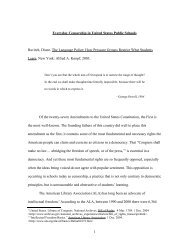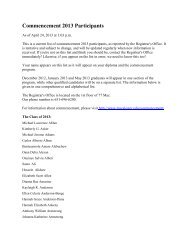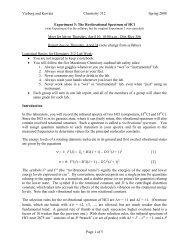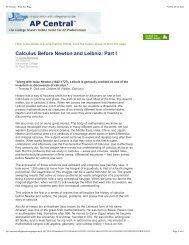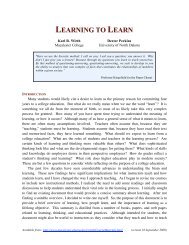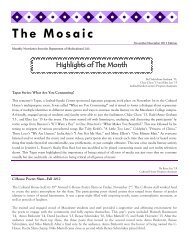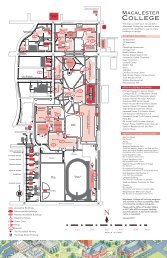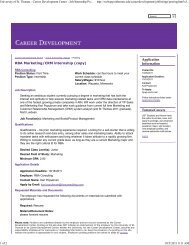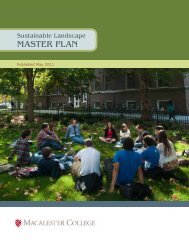INTERNATIONAL STUDENT HANDBOOK - Macalester College
INTERNATIONAL STUDENT HANDBOOK - Macalester College
INTERNATIONAL STUDENT HANDBOOK - Macalester College
Create successful ePaper yourself
Turn your PDF publications into a flip-book with our unique Google optimized e-Paper software.
Mac Customs<br />
The following description of Mac customs and behaviors is only a generalization;<br />
this information, although helpful, should be used as a guide and not as a prescription.<br />
One of the most helpful ways for anyone to learn about customs and behavior<br />
is by observing others and asking questions.<br />
It is important to realize attitudes and customs vary from person to person. Some of<br />
the following topics are delicate and may present the greatest cultural challenge for international<br />
students. Keep in mind that what follows are descriptions of general patterns<br />
of behavior.<br />
Clothing<br />
At <strong>Macalester</strong>, and on most U.S. campuses, students dress very informally. The most<br />
common attire (for both men and women) is a pair of blue jeans, a shirt, a sweater, and<br />
a small backpack. Student also dress informally off-campus, even when they attend<br />
social events such as athletics events and movies. In spite of this informality, however,<br />
a great many U.S. students enjoying dressing up, especially if they are going out to a<br />
restaurant or to a dance. *This is only a generalization<br />
It is important to allocate enough money for warm winter clothing as winter must be<br />
taken very seriously in Minnesota, where the temperature sometimes drops to -30ºF<br />
(-34ºC).<br />
Conversation<br />
Casual conversation between U.S. Americans can sometimes be confusing. For example,<br />
“How are you?” does not necessarily mean that the person asking wants to know<br />
how you are feeling. Most likely, what the person means is “Good morning” or “Hello.”<br />
In response, you may simply smile, nod, and say, “Fine, thank you. How are you?”<br />
Phrases said when departing can be equally confusing. For instance, “See you later,”<br />
“Drop by sometime,” or “Let’s get together sometime” are often meant as a friendly<br />
goodbye, rather than an actual invitation. When in doubt, do not be too shy to clarify<br />
whether it is an invitation or not. *This is only a generalization<br />
Social Space<br />
Some cultures tend to have a much closer conversational distance than does U.S. culture.<br />
As a result, an international person may literally back a North American across<br />
the room, each just unconsciously trying to maintain a comfortable distance. These<br />
subtle but important means of nonverbal communication can lead to the stereotype of<br />
particular foreign nationalities as forward and abrasive and North Americans as cold and<br />
distant. Conversely, the opposite may be perceived by students from a culture having a<br />
greater conversational distance than that of North Americans.<br />
Just as with conversational distance, personal space may differ across cultures. When<br />
North Americans are not acquainted with each other or when they are in public settings,<br />
they tend to stand or sit apart. For example, in an elevator, Americans will keep their<br />
distance unless crowding forces them together. The same is true in a bus where people<br />
sit one per seat until additional passengers force them to double up. In both of these<br />
examples, North Americans “hold themselves in,” having been taught from early childhood<br />
to avoid bodily contact with strangers. *This is only a generalization<br />
34







